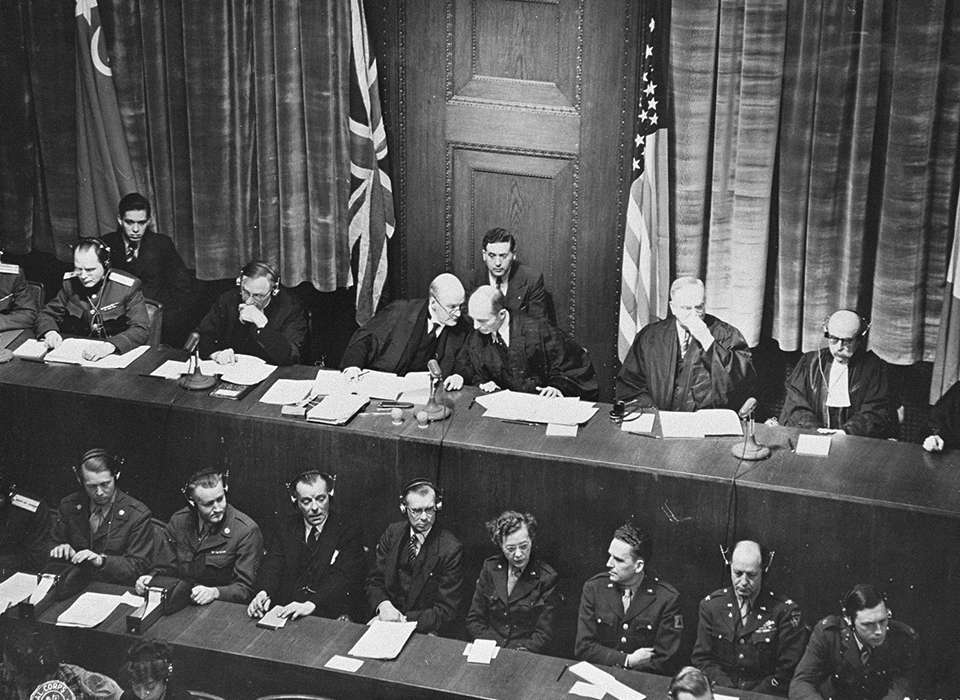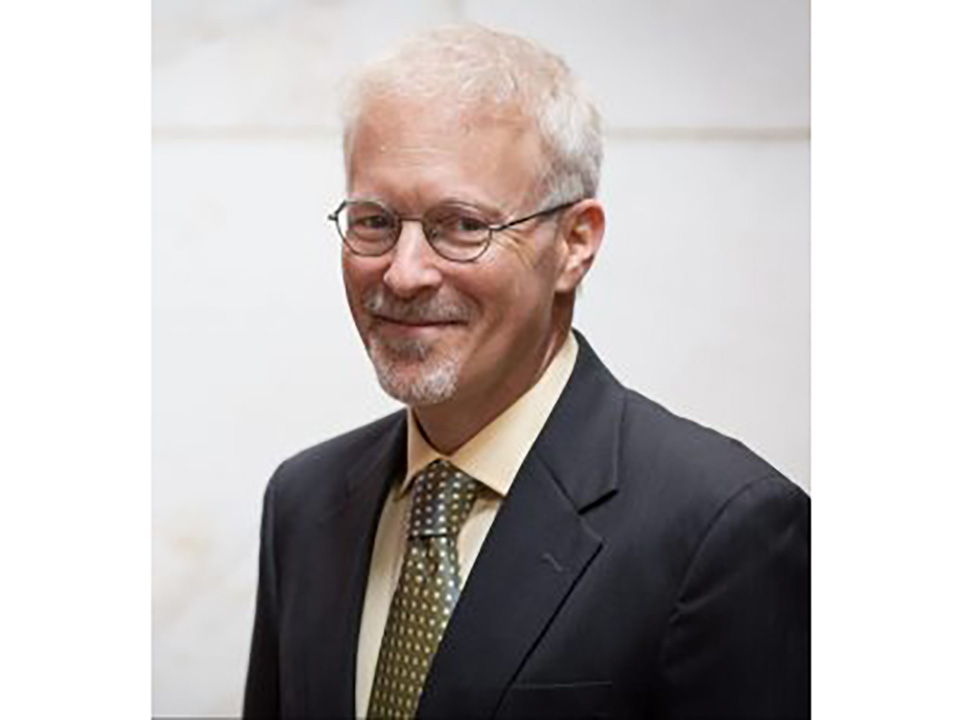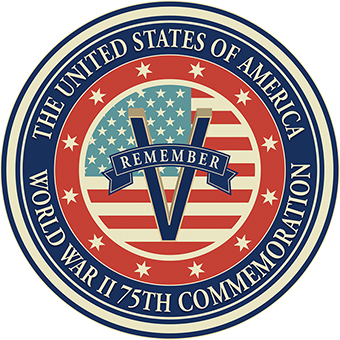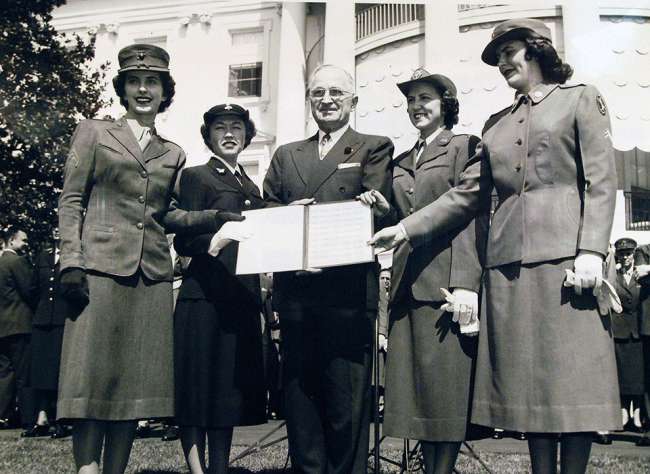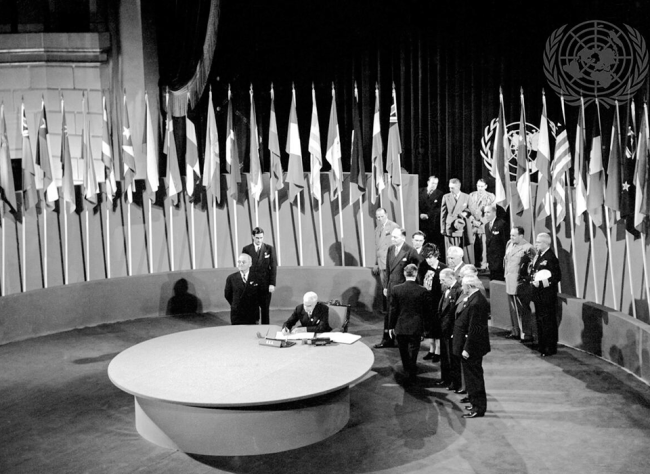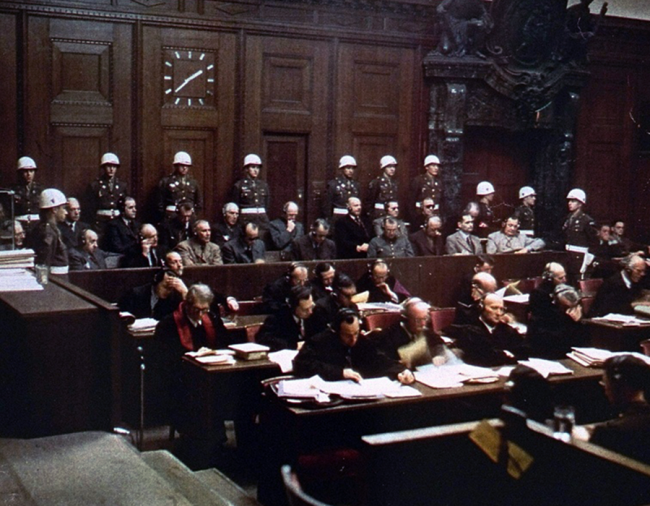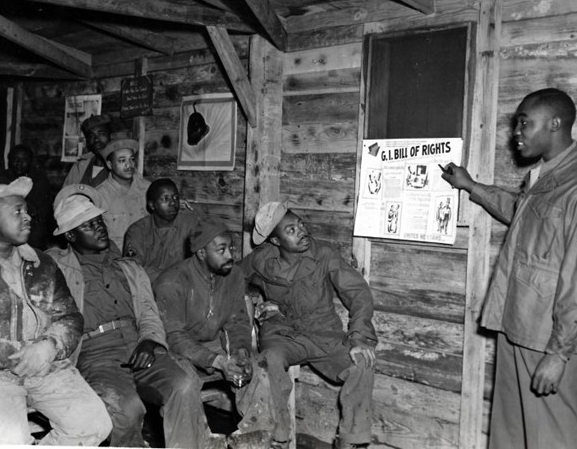Top Image: Judges of the International Military Tribunal. United States Army Signal Corps photo courtesy of the Harry S. Truman Library & Museum, 2004-437.
One of the great legal innovations of the post-war world is the concept of crimes against humanity. Aimed at the protection of civilian populations during both peacetime and wartime, even from civilian populations’ own governments, it remains a major pillar of international law to this day. The revolutionary concept was developed on the eve of the Trial of the Major War Criminals at Nuremberg (1945-1946), and then sharpened in subsequent US trials in occupied Germany between 1946 and 1949.
The world had been disturbed by mass crimes against civilians throughout the nineteenth and early twentieth century, ranging from atrocities during the Greek war of independence to pogroms against Jews in the Russian empire. The Hague Conventions of 1899 and 1907 were the first international agreements to define laws and customs of war on land and sea. But they limited themselves to outrages committed in wartime between states against one another’s soldiers, sailors, or civilians during and after combat operations. Deliberate abuses of a country’s own citizens were considered beyond the reach of international law. The Hague Conventions addressed those kinds of crimes only vaguely in their preambles, which noted that populations remained under protection of the “laws of humanity,” regarding incidents occurring outside the provisions of conventions themselves.
In May 1915 during World War I, the Entente powers of Great Britain, France, and Russia condemned the Ottoman Turkish government’s mass killing of its Armenian population in eastern Anatolia by referring to “new crimes … against humanity and civilization.” Delegates at the Paris Peace Conference in 1919 hoped to hold Turkish officials criminally responsible. But the US delegation, though equally appalled by Turkish actions, rejected the notion that prosecutions could occur without an existing statute. Though the Germans could be prosecuted for combat and occupation related war crimes under various articles of the Hague Conventions, the vague reference to laws of humanity were not enough to try Turkish offenders.
The unprecedented nature of Nazi Germany’s crimes against Jews and other civilian populations in Europe were clear to governments-in-exile, Allied diplomats, and neutral observers who received reports from German-occupied Europe throughout World War II. It was also certain that Nazi crimes against civilian populations were distinct from German military operations, that crimes on a large scale had begun before the war against Jews and others who were actually German citizens, and that these crimes were systematic in nature, carried out at the behest of the government and not by a few rogue military or police officers without official approval.
President Harry Truman selected Supreme Court Justice Robert Jackson Trial of the Major War Criminals at Nuremberg to represent the United States at the June-July 1945 London Conference, which created the machinery for the International Military Tribunal, the court that would try the major Nazi criminals at Nuremberg. Jackson had known Hersch Lauterpacht, a distinguished scholar of international law originally from the Lvov region of East Galicia who had immigrated to England in the 1920s and who was now on the British legal team. Lauterpacht still did not know the fate of his family in the Lvov region; as Jews they had all been murdered. In the wake of World War II, Lauterpacht and Jackson sought a new kind of legal instrument to address Nazi crimes.
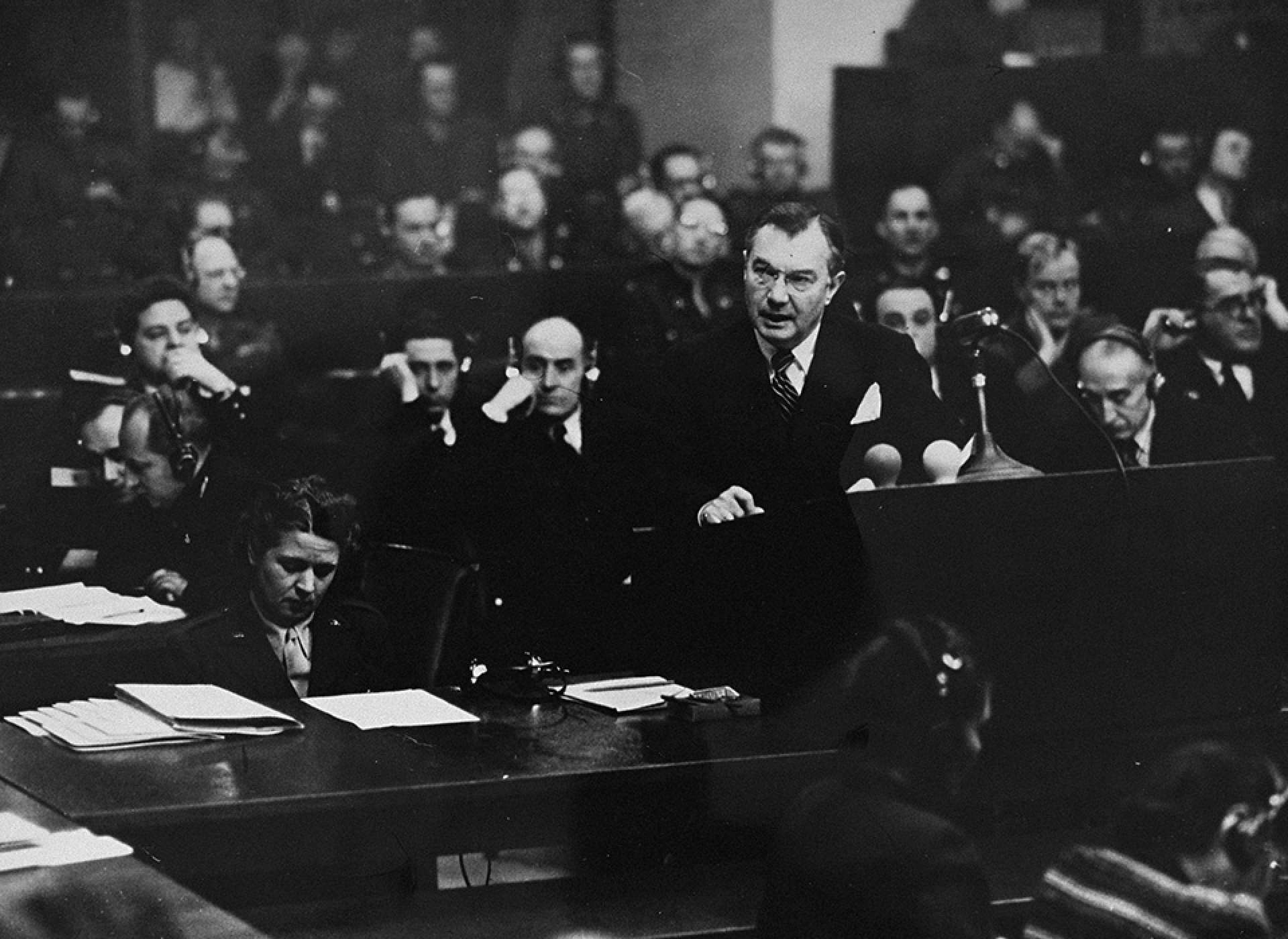
Justice Robert Jackson at the Nuremberg Trial. The United States Holocaust Memorial Museum, courtesy of Harry S. Truman Library.
The London Charter of August 8, 1945 established the International Military Tribunal. Article 6 of the Charter contained the laws under which the Tribunal would try the major Nazi criminals ranging from government ministers to top military commanders. These were Crimes against Peace (i.e., launching a war of aggression), conventional war crimes as established by the Hague Conventions, and Crimes against Humanity, defined by article 6 c as follows:
murder, extermination, enslavement, deportation, and other inhumane acts committed against any civilian population, before or during the war; or persecutions on political, racial or religious grounds in execution of or in connection with any crime within the jurisdiction of the Tribunal, whether or not in violation of the domestic law of the country where perpetrated.
The most important legal innovations included “any civilian population,” “before or during the war,” and “whether or not in violation of the domestic law of the country where perpetrated.” In theory, international law could hold Nazi leaders criminally liable for offenses against their own citizens in peacetime, irrespective of whether domestic law permitted their actions. The vague statements of the Hague Conventions concerning the “laws of humanity” now had teeth. After the Trial of the Major War Criminals concluded, Truman wrote Francis Biddle, the US judge at Nuremberg, that, “An undisputed gain coming out of Nuremberg is the formal recognition that there are crimes against humanity.”
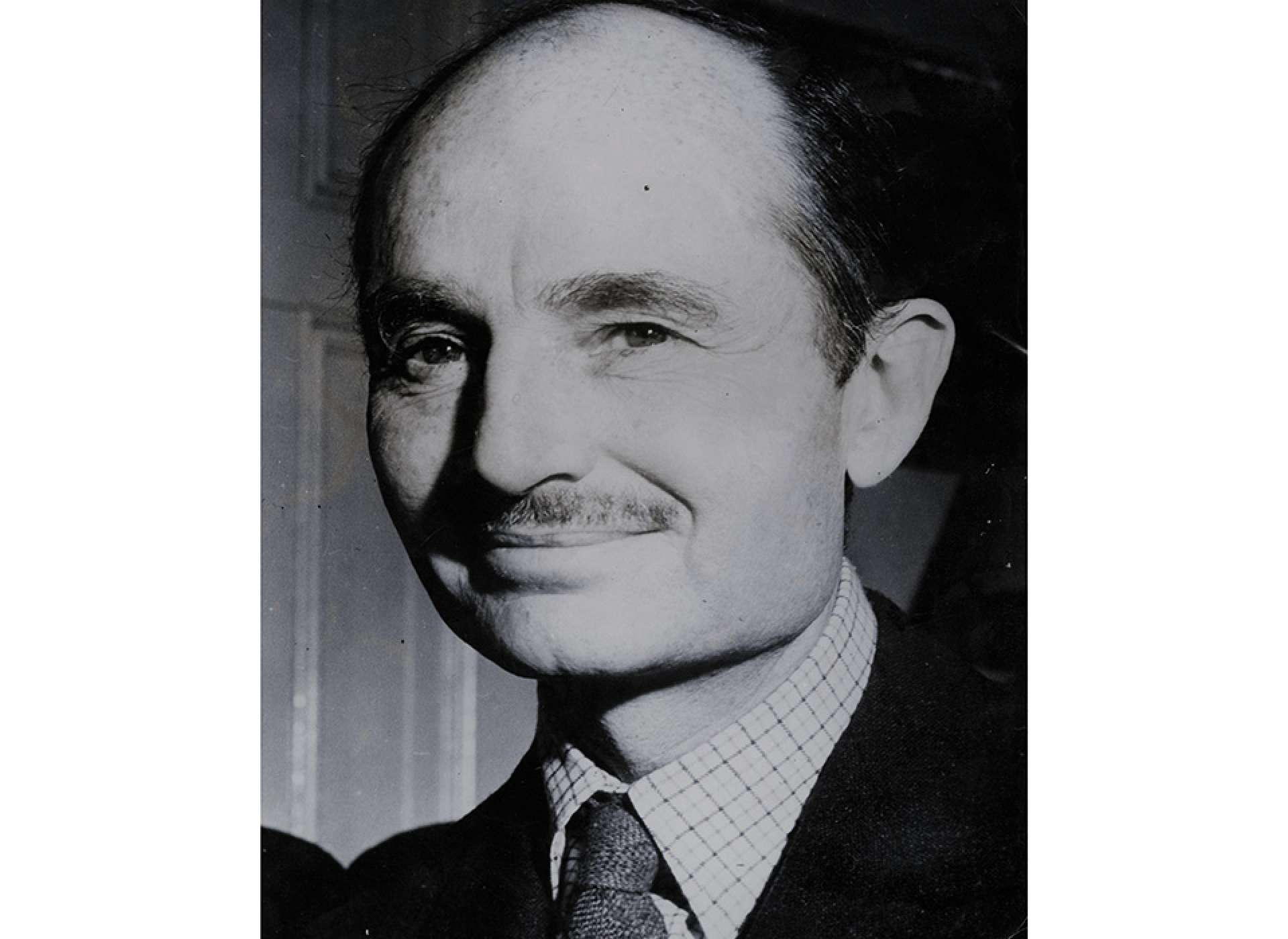
Francis Biddle. The National WWII Museum, Gift of Dylan Utley, 2012.019.756.
Yet the new concept was not accepted as a whole. On the eve of the trial, the English and French texts of Article 6 c were harmonized with the Russian text, substituting a comma for the possibly mistaken semicolon between the phrases “during the war” and “or persecutions.” The comma tied the two parts of the law together so that a crime against humanity only occurred legally if it was committed “in execution of or in connection with any crime within the jurisdiction of the Tribunal,” that is, in connection with aggressive war or conventional war crimes. This phrasing became known as the “war nexus.” It meant that pre-war Nazi actions against German civilians were not crimes against humanity by the language of the London Charter unless prosecutors could tie such acts to the primary crime investigated by the tribunal, Germany’s preparations for war.
The small adjustment in punctuation limited the reach of the new concept for those remaining uncomfortable with the primacy of international law over individual state sovereignty. It might have eased the minds of the Soviets, who had persecuted whole populations within the Soviet Union on political and ethnic grounds; the British and the French, who had committed violent acts within their empires (the French at Sétif in Algeria on V-E Day itself); and even the United States for its own racial discriminatory policies. As Jackson himself said, “we have some regrettable circumstances in our own country in which minorities are unfairly treated.” Historians argue today that the required war nexus existed in the case of Nazi Germany. Its pre-war persecution of political opponents and Jews was aimed at preventing a stab-in-the-back during wartime, which the Nazis believed responsible for Germany’s defeat in 1918. But this was not fully understood at Nuremberg.
The International Military Tribunal’s judgment in October 1946 ruled that pre-war Nazi actions against German Jews, German political opponents, and others, “revolting and horrible as many of these crimes were,” were not crimes against humanity as defined in the Charter and were thus not criminal in the eyes of the court. On the other hand, the tribunal ruled that the Germans had committed numerous crimes against humanity during the war. German war crimes against civilians being so extensive, ranging from the mass deportation of resistors to slave labor in concentration camps to mass starvation on the Eastern front to mass shooting in the USSR to mass gassing in Poland, the judgment did not parse between war crimes and crimes against humanity. It mixed them in a joint category, noting that “from the beginning of the war in 1939, War Crimes were committed on a vast scale, which were also Crimes against Humanity….”
It was up to subsequent tribunals to sharpen the concept of crimes against humanity. In December 1945, the four occupation powers in Germany issued Control Council Law No. 10. The law governed the judicial punishment of lower-level Nazi perpetrators. Crimes against humanity were included in the charter, but redefined. They defined additional specific crimes such as torture and rape. Crimes against humanity also stood on their own, separated from crimes against peace, as the war nexus was absent from the text. Article II c of Control Council Law No. 10 thus defined crimes against humanity as follows:
Atrocities and offenses, including but not limited to murder, extermination, enslavement, deportation, imprisonment, torture, rape, or other inhumane acts committed against any civilian population, or persecutions on political, racial or religious grounds whether or not in violation of the domestic laws of the country where perpetrated.
American Military Tribunals held 12 “subsequent” trials in Nuremberg between 1946 and 1949. Most of these American tribunals focused on a distinct professional segment of German society to demonstrate how that segment had diverged from western liberal traditions. The cases included a “Medical Case” against German physicians; a “Justice Case” against German jurists including judges and prosecutors; a “High Command Case” against senior German military officers; a “Ministries Case” against senior government officials; three separate cases against leading industrialists, and so on.
Most of the 183 defendants in the subsequent Nuremberg trials were indicted for war crimes and crimes against humanity, and many were convicted of both. Taken together, the tribunals managed to come to some consensus on what exact factors defined crimes against humanity. For instance, the law’s reference to civilian populations meant for the tribunals that crimes against humanity were not isolated incidents, but mass crimes, systematic in nature, committed as a measure of state. They were also committed not in occupied territory such as Poland or the Soviet Union, where even particularly severe mass crimes against civilians were still governed by the Hague Conventions as war crimes, but in friendly unoccupied regions such as Hungary, a German ally during the war. Thus Edmund Veesenmayer, the Reich plenipotentiary in Hungary in 1944, was found distinctly guilty of crimes against humanity for facilitating the deportation of Hungary’s Jews to Auschwitz.
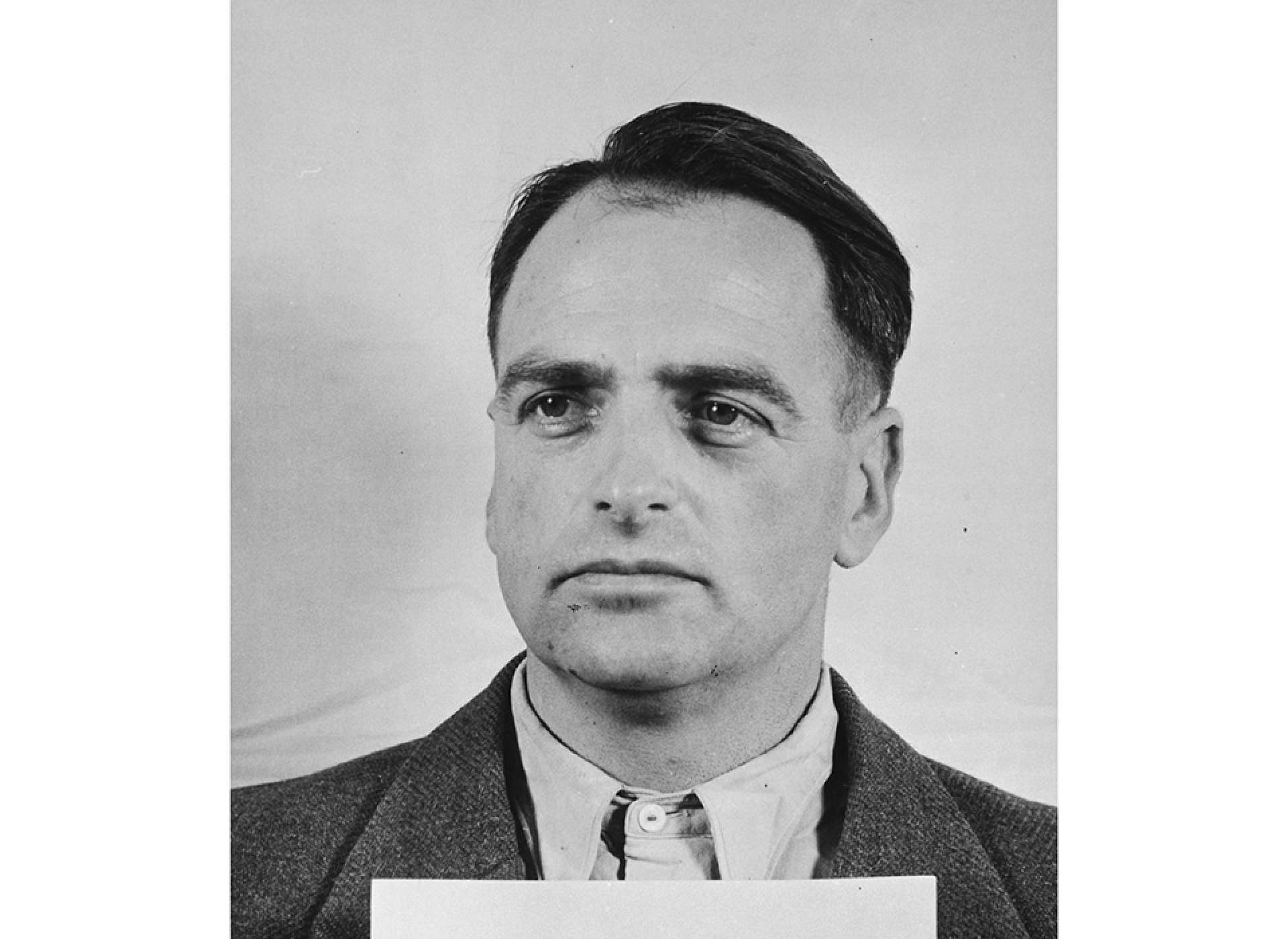
Edmund Veesenmayer. United States Holocaust Memorial Museum, courtesy of Robert Kempner.
The tribunals were split on the more daring aspects of the crimes against humanity statute. The judges were not innovative juridical scholars. They came from state courts in the United States rather than US federal courts, none had international law experience, and most were conservative concerning the ability of international statutes to trump national sovereignty. Thus, in considering pre-war Nazi crimes against humanity, most of the tribunals assumed the validity of the war nexus from the London Charter, even though Control Council Law No. 10 had deliberately omitted it, and even though US officials had proposed an amendment defining crimes against humanity as having taken place from the moment the Nazis assumed power in January 1933. The tribunal trying senior members of the Friedrich Flick coal and steel concern argued that the omission of the war nexus in Control Council Law No. 10 was surely accidental, and that consequently the tribunal had no jurisdiction over pre-war German actions. The tribunal trying Oswald Pohl and members of the SS Economic Administrative Main Office argued that domestic German laws, even those imposed by Nazi terror, were the business of the German people, not the tribunal itself.
Consequently, the tribunals were also cautious with regard to Nazi crimes against German nationals. The Nuremberg Medical Case focused primarily on wartime medical experiments on foreign nationals in concentration camps. The tribunal touched on mass killings of the disabled under Nazi Germany’s euthanasia program mass killings of the disabled under Nazi Germany’s euthanasia program, as lead defendant Karl Brandt had headed the program, but it excluded euthanasia killings of German nationals as criminal. Rather its judgment pointed out that “almost at the outset of the program non-German nationals were selected for euthanasia.” The same tribunal tried members of the Race and Settlement Main Office and concluded that in the case of Richard Hildebrand, the Higher SS and Police Leader in Danzig-West Prussia, that “euthanasia, when carried out under state legislation against citizens of the state only, does not constitute a crime against humanity.”
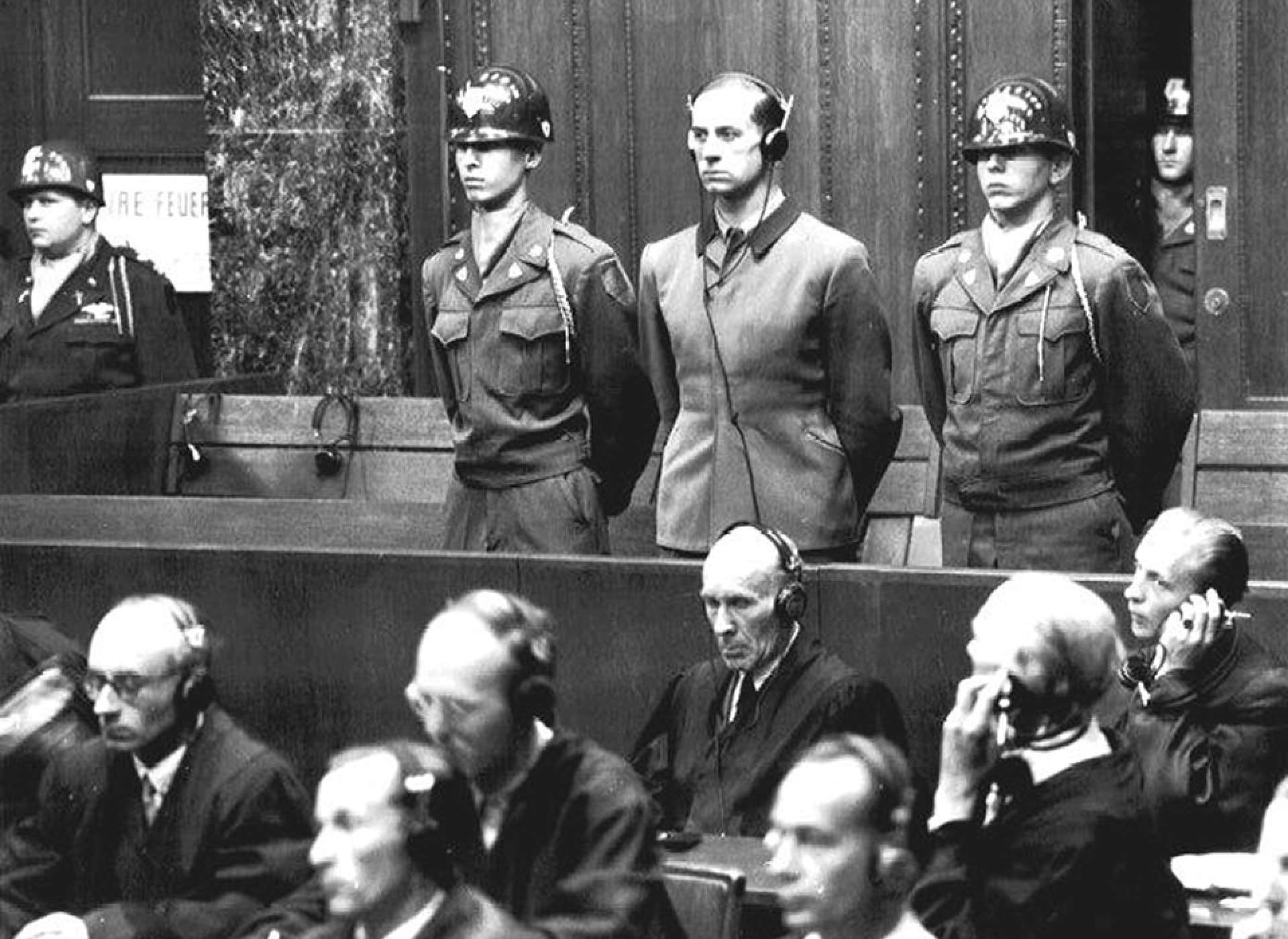
Karl Brandt on trial at the Palace of Justice in Nuremberg, Germany. US Army. Photo No. OMT-I-D-144.
The American tribunal for the “Justice Case” was more audacious, perhaps as it was forced to grapple with the validity of German law itself. Though the defendants were not tried for their pre-war activities, they were tried for wartime transgressions against “any civilian population,” including German Jews. The court also noted that many of the defendants’ transgressions–ranging from approving seizure of Jewish property to selective prosecution of Jews to the denial of civil status to Jews in German courts, to the punishment of sexual crimes having to do with racial mixing–were based on laws that appeared between 1933 and 1939 which the tribunal deemed arbitrary.
The tribunal thus had no patience with the defense arguments that German law legitimized the defendants’ actions, or that crimes against humanity was a law unjustly applied after the fact–ex post facto. “The Nuremberg Tribunals,” read the judgment, “are not enforcing German law…. On the contrary, the jurisdiction of this tribunal rests on international authority.” The defendants were proven to be willing political advocates of extra-Nazi programs. They acted based on ideology rather than law, confident that they would never be held to account.
American jurists in occupied Germany developed international law with the concept of crimes against humanity, then grappled with its meaning, refining it within an emerging post-war world. It was up to the international community to develop the concept further.
In December 1946, the UN General Assembly affirmed the legal principles of the London Charter and stated its intention to incorporate them into an international criminal code. The Cold War slowed this process due to differences over how certain crimes, from aggressive war to crimes against humanity itself, were to be defined. In 1996, owing to the end of the Cold War and the mass killings of civilians in Yugoslavia and Rwanda civil conflicts, the UN revisited the Nuremberg principles when creating ad hoc tribunals to adjudicate mass killings in those countries and in developing the 1998 Rome Statute for the International Criminal Court, which re-defines crimes against humanity.
The Rome Statute, adhered to by 123 countries, expands the list of individual crimes against humanity to include a variety of sexual crimes as well as “Other inhumane acts of a similar character intentionally causing great suffering, or serious injury to body or to mental or physical health.” Critical too, however, is this. As contemporary mass atrocities have occurred within states rather than between them, the nexus connecting crimes against humanity to international war has been removed once and for all. In theory and practice, state officials are responsible to the international community for the treatment of their own citizens.
Meet the Author
Norman JW Goda is the Norman and Irma Braman Professor of Holocaust Studies at the University of Florida. He received his PhD from the University of North Carolina at Chapel Hill. He studies modern European history and specializes in the history of the Holocaust, war crimes trials, and twentieth century diplomacy. He teaches courses on the Holocaust and Nazi Germany from historical and interdisciplinary perspectives. Goda has published extensively and served as a consultant to the US and German governments, as well as for various radio, television, and film documentaries in the US, Europe, and Israel.
Further Reading
Bassiouni, M. Cherif. Crimes Against Humanity: Historical Evolution and Contemporary Application. New York, 2014.
Douglas, Lawrence. The Memory of Judgment: Making Law and History in the Trials of the Holocaust. New Haven, CT, 2001.
Heller, Kevin Jon. The Nuremberg Military Tribunals and the Origins of International Criminal Law. New York, 20212.
Pendas, Devin O. Democracy, Nazi Trials, and Transitional Justice in Germany, 1945-1950. (New York, 2020).
Priemel, Kim Christian. The Betrayal: The Nuremberg Trials and German Divergence. New York, 2016.
Sands, Philippe. East West Street: On the Origins of “Genocide” and “Crimes Against Humanity.” New York, 2016.
This article is part of a series commemorating the 75th anniversary of the end of World War II made possible by the Department of Defense.
Cite this article:
MLA Citation:
APA Citation:
Chicago Style Citation:
